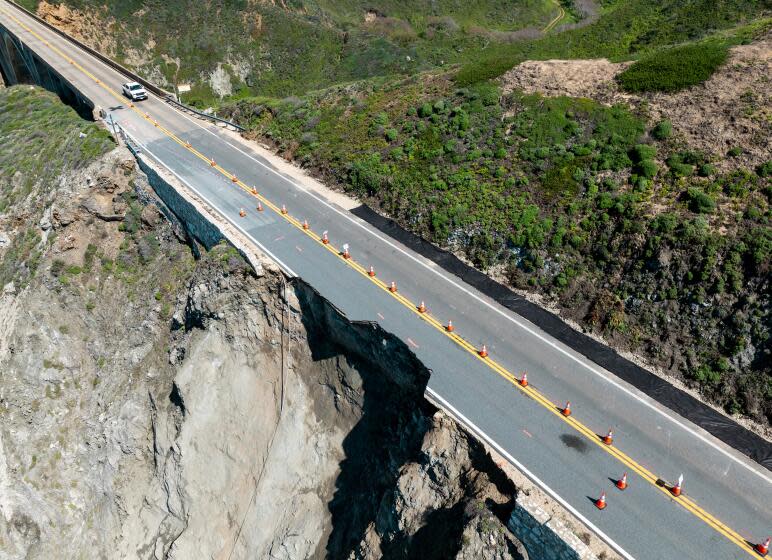California roads damaged by storms could get help with Newsom's emergency declaration

- Oops!Something went wrong.Please try again later.
Gov. Gavin Newsom proclaimed a state of emergency Friday to help fund badly needed repairs of roads battered during this year's storms, including scenic Topanga Canyon Boulevard that was blocked by millions of pounds of debris.
The governor's action comes two weeks after California Department of Transportation officials said the massive, 300-foot-tall landslide that covered Topanga Canyon Boulevard in March with mud and rocks would not be cleared until fall, "if all things go well."
The proclamation enables Caltrans to request funding from the Federal Highway Administration's Emergency Relief Program, which could cover up to 100% of the repairs, according to the governor's office.
It would also help state officials secure federal aid for other roads damaged by the torrential rains, including a portion of Highway 1 in Big Sur that crumbled and fell into the ocean.
"Storms in March caused significant damage to critical parts of our transportation infrastructure — impacting not only traffic for our communities, but also hurting small businesses and workers," Newsom said in a statement. "The state is working overtime to complete repairs as safely and as quickly as possible, and I have signed a state of emergency proclamation which will help ensure that we receive critical federal funding to help impacted communities bounce back from these devastating storms."
Read more: Topanga Canyon could remain closed into the fall after massive landslide
Much of California was drenched with storms in early 2024, with Southern California seeing more than a year's worth of rain in just a few weeks, causing mudslides and floods.
On Topanga Canyon Boulevard, officials said the landslide that now covers the road at milepost 1.8 is more than twice as large — with about 80,000 cubic yards of debris covering the area — as the massive landslide that occurred in the area in the 1940s.
The incident has caused residents to make hours-long detours and local businesses to lose revenue, according to the governor's office.
Because of the instability of the slope and water that continues to seep out of the landslide, Caltrans officials on April 18 said clearing the road would require crews to remove the dirt from the top of the slide. Workers plan to work their way down the mass of debris to keep more dirt and boulders from sliding from the hill.
When a portion of Highway 1 in Big Sur crumbled on Easter weekend, the road closure also stranded tourists and locals. This week, twice-a-day convoys resumed along one lane of the damaged section to allow residents, workers and visitors to enter and exit the area.
The emergency declaration also covers storm-damaged roads in Alameda, Contra Costa, Los Angeles, Marin, Mendocino, Monterey, Napa, Nevada, Plumas, San Bernardino, San Mateo, Santa Barbara, Santa Clara, Santa Cruz, Solano, Sonoma, Trinity and Ventura counties, according to the governor's office.
Read more: California granted federal disaster relief for historic February storms
According to the Federal Highway Administration, the work must be completed within 270 days, but extensions can be requested.
This story originally appeared in Los Angeles Times.

